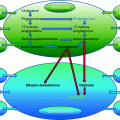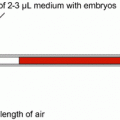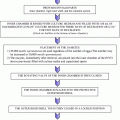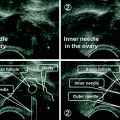Author
Type of study
Patient diagnoses
Number of cases
CPR/transfer (%)
Cases cancelled for OHSS risk
No transfer (cryo) for OHSS risk
Coasting for OHSS risk
Hospitalized for OHSS risk
Moderate or severe OHSSb
(% of cases)
Total OHSS burdenc
(% of cases)
Gremeau et al. [30]
Retrospective case control
PCO and PCOS matched for age, diagnosis, and ovulatory status
IVF–97
IVM–97
49/90 (54.4)
19/93 (20.4)
Not stated
0
4
0
9
0
8
0
8 (8.2)
0
14 (14.4)
0
Child et al. [31]
Retrospective case control
PCO pattern matched for age, diagnosis, and month of procedure
IVF–107
IVM–107
36/105 (34.3)
23/105 (21.9)
1
0
0
0
Not stated
0
1
0
12 (11.2)
0
13 (12.1)
0
Based on the available data, IVM eliminates severe OHSS in patients who are candidates for IVM. If one views the primary benefit of IVM as its ability to reduce the incidence of OHSS, then it is worthwhile to try to understand what burden OHSS presents for IVF. At present, IVM is primarily used for patients with ovulatory PCO and anovulatory PCO (PCOS) [21–24, 29–31]. In 2006, Heijnen et al. published a meta-analysis of case-control studies of IVF cycles in patients with and without PCOS [6]. They found nine studies meeting their criteria, but these uncommonly provided information on cycle cancellations for hyper-response or on the incidence of OHSS. Overall cycle cancellation (for any reason) was four times as frequent for PCOS patients than for non-PCO patients. Three studies provided information on OHSS. In one study, two patients (11%) were hospitalized for moderate to severe OHSS. The second study reported a 16.9% incidence of mild to moderate OHSS and a 3.9% incidence of severe OHSS. The third study reported two cases of OHSS in PCOS patients and one case in a non-PCO patient. At best, we conclude that OHSS is not uncommon in IVF patients with PCOS. Again, our understanding of the factors influencing the development of OHSS and the differences between IVM and IVF suggests that OHSS should not occur with IVM in patients with PCOS. IVM also prevents the discomfort that patients feel due to mild OHSS after IVF. The number of such patients involved is even harder to quantify, but avoiding pain and discomfort in patients is a routine part of good medical care.
Diverse management approaches or treatments for patients either known to be at high risk for OHSS before the start of an IVF cycle or who become high risk for OHSS in the course of an IVF cycle have been advocated. Some of the patients who become high risk for severe OHSS during a cycle are managed by cycle cancellation prior to oocyte aspiration and they incur considerable wasted expense in terms of medications, monitoring costs, and time missed from work. In 2012, more than 2400 women in the USA under age 35 had cycles cancelled prior to oocyte aspiration [8]. At least some of these cancellations were due to OHSS risk. In an ESHRE questionnaire survey, up to 20% of IVF physicians would manage patients having very high estradiol levels by cycle cancellation [1]. In a Web-based Internet study, 18% of physicians from 262 centers and 68 nations would also manage a patient with a very high risk of severe OHSS by cycle cancellation [32].
There are several treatments to mitigate or prevent the development of severe OHSS that are widely used. They are not as effective as IVM because they are less effective in modifying the impact of VEGF on the patient (Table 23.2). Most of these interventions impose extra burdens on patients that they would not experience with IVM (Table 23.3).
Table 23.2
Treatments to avoid or mitigate OHSS and their probable impact via VEGF
Treatment | Impact | Comments |
|---|---|---|
Freeze-all approach | Avoids impact of hCG from pregnancy, thus avoiding late increased VEGF production by rescued corpus luteum | Avoids late-onset OHSS. Likely speeds resolution of early-onset OHSS |
Coasting | Downregulates VEGF gene expression and decreases potential of granulosa cells to produce VEGF by causing apoptosis [9] | No impact on late-onset OHSS |
Albumen infusion | Unclear | Mitigates impact of increased vascular permeability |
GnRH agonist | Attenuated LH surge caused by GnRH agonist leads to impaired development of corpus luteum with early and complete lysis of corpus luteum [33] | |
Dopamine agonist | Long treatment course needed to impact both early- and late-onset OHSS | |
Pericentesis | May decrease VEGF availability by the removal of fluid containing VEGF | Highest production of VEGF occurs 48 hours after hCG [35] |
IVM | Oocytes are removed before adequate granulosa cells are available to produce very high levels of VEGF. HCG is given before the follicular unit is fully capable of responding. No corpus luteum is formed | Effective for both early- and late-onset OHSS |
Table 23.3
Advantages and disadvantages of treatments to avoid or mitigate OHSS
Treatment | Advantages | Disadvantages | Comments |
|---|---|---|---|
Cycle cancellation | Avoids risks and limits discomfort of OHSS. Enables physicians to achieve a better outcome next cycle | Loss of resources used for current cycle. Disruption of patient’s plans | Patient may not be able to undertake another cycle for economic or psychological reasons |
Freeze-all approach | Avoids worsening a high-risk situation by production of hCG if pregnancy were to occur | Delays time to pregnancy for patient. Incurs additional costs associated with cryopreservation and delayed embryo replacement | Insurance may not pay for additional associated costs |
Coasting | Decision to coast can be made late in the ovulation induction | Lengthens cycle and adds monitoring costs. Cycle may need to be cancelled if estradiol drops too quickly or not quickly enough | Significant OHSS may still occur [36] |
Albumen infusion | Treats some symptoms of OHSS | Not sufficiently adequate alone | Meta-analysis suggests that this saves one case of severe OHSS for every 18 high-risk women [37] |
GnRH agonist | Easy to use as long as all high-risk patients utilize antagonist ovulation inductions | Requires careful management of luteal phase and early pregnancy. Ascertaining adequacy of induced LH surge may be useful. Mild and moderate OHSS can still occur | |
Dopamine agonist | Easy to use | Need long duration of medications to reduce both early and late OHSS | |
Pericentesis | Enables management of severe OHSS as outpatient [7]. Improves hospital management of OHSS | Can be unpleasant for the patient without anesthesia | Patients experiencing a cycle where this was required are unlikely to want to repeat it |
IVM | Prevents early- and late-onset OHSS. Symptoms related to high estradiol levels avoided. Simpler, gentler, cheaper, shorter duration cycles than conventional IVF | Lower pregnancy rates per cycle than conventional IVF in most published studies | Requires management of early pregnancy until placental function adequate |
The most effective of these (after IVM) is using a GnRH agonist to trigger oocyte maturation. GnRH agonists produce an LH surge that is shorter in duration than a physiological surge. This LH spike is adequate to promote oocyte maturation, but not adequate to establish a corpus luteum. Early luteolysis eliminates the period of highest production of VEGF and also prevents late-onset OHSS since there is no corpus luteum to be rescued. Some of this benefit may be lost with the concomitant use of low doses of hCG, which may be used with a GnRH agonist trigger to improve the pregnancy rate. This is because the half-life of hCG is much longer than that of LH, and hCG activates the VEGF system more effectively than does LH [33, 40]. Table 24.4 is a sample listing of reports in the literature of OHSS occurring in cycles utilizing a GnRH agonist to trigger oocyte maturity. One may hypothesize that these episodes of OHSS are due to severe OHSS occurring prior to the use of GnRH agonist, an atypical response by the patient to GnRH agonist, a confounding effect of low-dose hCG use, or a genetic mutation of the FSH or VEGF receptor. Similar to IVM for which a corpus luteum is not present, when a GnRH agonist is used, the luteal phase and early pregnancy need to be managed with supplemental estrogen and progesterone (Table 23.4).
Table 23.4
OHSS after use of GnRH agonists to trigger oocyte maturation
Author | Cases | Oocyte maturation | Comments |
|---|---|---|---|
Van der Meer et al. [41] | Three cases of moderate OHSS in 27 high-risk patient cycles | 2.4 mg buserelin acetate | |
Gerris et al. [42] | One case of moderate OHSS out of 9 cases | 0.5 mg GnRH | |
Lee et al. [43] | Clinically significant OHSS in 6 out of 50 cases. Three cases were hospitalized | 0.2 mg triptorelin with 500 U HCG given on day of retrieval | |
Griesinger et al. [44] | One case of severe early-onset OHSS out of 51 patients | 0.2 mg triptorelin | |
Griffin et al. [45] | One case of mild OHSS out of 34 with dual trigger. None with GnRHa only (n = 68) | 1 mg luprolide acetate. Dual trigger used 1000 U hCG at same time | Clinical pregnancy rate 58.8% with dual trigger and 30.9% without |
Shapiro et al. [34] | One case of clinically significant late-onset OHSS out of 182 using dual trigger. No significant OHSS in patients with GnRH agonist only (n = 115) | 4 mg luprolide acetate. Dual trigger used 33 U hCG/kg at same time | Highest pregnancy rate with dual trigger. Decrease in pregnancy loss rate with dual trigger or enhanced luteal support |
Radesic and Tremellen [46] | One case of severe OHSS requiring hospitalization out of 71 cases | 2 mg luprolide acetate with 1500 U hCG at retrieval | |
Humaidan et al. [47] | Two cases of moderate late-onset OHSS in high-risk dual trigger group. Two cases of severe late-onset OHSS occurred in low-risk group with extra hCG dose | 0.5 mg buserelin with 1500 U hCG at same time and second low risk for OHSS group getting second dose of 1500 U hCG on day of retrieval
Stay updated, free articles. Join our Telegram channel
Full access? Get Clinical Tree
 Get Clinical Tree app for offline access
Get Clinical Tree app for offline access

|




